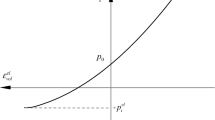Abstract
Full-scale lateral static load tests performed on rectangular barrette sections are commonly limited due to their large capacity and high testing cost. The soil–barrette system behaves nonlinearly, making it convoluted to understand its real behavior. In the present study, finite element analysis is utilized to simulate the soil–structure interaction of a full-scale lateral load test carried out on a large-section rectangular reinforced concrete barrette in Hong Kong. The effect of the tension cracking, in the reinforced concrete sections, on the flexural stiffness of the rectangular barrette under static lateral loading–unloading cycles is explored. A proposed approach of sequential decreasing the flexural stiffness, based on the ratio between the affecting and the cracking bending moment of the concrete section, to simulate the real concrete behavior resulting from the cracking effect, is applied in the developed numerical model for the case study. The conducted study showed that the proposed approach adopted to simulate the decrease in the concrete stiffness based on the bending moment level is reasonable to represent the actual response of the barrette to lateral loads and provides a practical alternative to the costly field loading tests.










Similar content being viewed by others
References
Aslani F, Jowkarmeimandi R (2012) Stress-strain model for concrete under cyclic loading. Mag Concr Res 64(8):673–685. https://doi.org/10.1680/macr.11.00120
ACI (1993) Bridges, substructures, sanitary, and other special structures-structural properties. American Concrete Institute (ACI) manual of concrete practice, Part 4. Detroit
ACI 318M-14 (2015) Building code requirements for structural concrete and commentary. Reported by ACI committee 318
Brinkgreve RBJ, Vermeer PA (1998) PLAXIS-version 7, finite-element code for soil and rock analyses user’s manual. Rotterdam, A.A. Balkema
Brinkgreve RBJ, Broere W (2004) PLAXIS 3D tunnel manual. Version 2 online manual
Brinkgreve R (2005) Selection of soil models and parameters for geotechnical engineering application. GeoFrontiers Soil Const Model, pp 69–98. https://doi.org/10.1061/40771(169)4
Guo WD (2014) Case studies on response of laterally loaded nonlinear piles. Geotech Eng 45(2):70–77
Muthukkumaran K (2014) Effect of slope and loading direction on laterally loaded piles in cohesionless soil. Int J Geomech 14(1):1–7. https://doi.org/10.1061/(asce)gm.1943-5622.0000293
NAVFAC-DM (1986) Foundations and earth structures. Des Man 7:02
Ruseta P (1996) Prediction and evaluation of a laterally loaded pile group. PhD thesis. Univ. of Florida, Gainesville, Fla
Ruseta PF, Townsend FC (1997) Evaluation of laterally loaded pile group at Roosevelt Bridge. J Geotech Geo-environ Eng 123(12):1153–1161. https://doi.org/10.1061/(ASCE)1090-0241(1997)123:12(1153)
Said SE, Fayed AL, El Mossallamy Y (2020) P–y curves of laterally loaded piles near earth slopes. Int J Eng Adv Technol (IJEAT). https://doi.org/10.35940/ijeat.D7763.049420
Wong YS, Kok ST, Choong WK, Mohamed AA, (2018) Modelling and validation of 3D FEM for laterally loaded single pile. Int J Integr Eng 10(4):193–198. https://doi.org/10.30880/ijie.2018.10.04.030
Yang M, Deng B, Wang Y (2019) A simplified calculation method for the near-slope laterally loaded pile based on a passive wedge model. Adv Civ Eng 2019:8363252. https://doi.org/10.1155/2019/8363252
Yin P, He W, Yang ZJ (2018) A simplified nonlinear method for a laterally loaded pile in sloping ground. Adv Civ Eng. https://doi.org/10.1155/2018/5438618
Zhang LM (2003) Behavior of laterally loaded large-section barrettes. J Geotech Geo-environ Eng 129(7):639–648. https://doi.org/10.1061/(ASCE)1090-0241(2003)129:7(639)
Author information
Authors and Affiliations
Corresponding author
Rights and permissions
About this article
Cite this article
Mansour, M.M., Fayed, A.L. & Morsi, M.M. Numerical simulation for the nonlinear behavior of laterally loaded barrettes. Innov. Infrastruct. Solut. 6, 26 (2021). https://doi.org/10.1007/s41062-020-00392-x
Received:
Accepted:
Published:
DOI: https://doi.org/10.1007/s41062-020-00392-x




